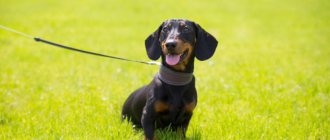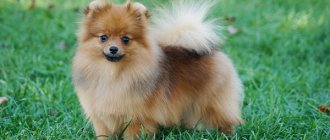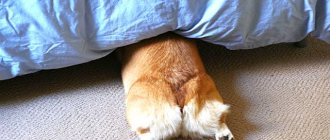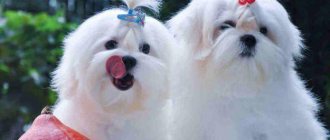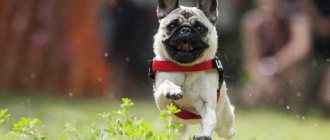According to the classification adopted by the Fédération Cynologique Internationale (FCI), Labradors are classified in the VIII breed group of Retrievers. The full name of the breed is Labrador Retriever.
In addition to Labrador, the group includes 5 more breeds - Nova Scotia, straight- and curly-haired, golden (golden) and Chesapeake Bay retrievers.
The name “retriever” (in English “retriever” - the one who returns, brings) indicates the specialization of dogs. All of them were bred for gun hunting, their main purpose is to find and bring back shot undamaged game.
All dogs in the group have high intelligence, good trainability, good disposition and universal working qualities.
History of the Labrador Retriever breed
Labrador Retriever
Whatever geographic associations you may have, researchers have not found a direct connection between Labradors and the North American peninsula of the same name. The version of the origin of the breed from the island of Newfoundland, located southeast and now part of the youngest Canadian province, is considered historically reliable.
The origin of the name of the breed is explained by different theories. According to one, the original color (exclusively black) resembled the igneous rock found in their homeland - labradorite. Supporters of the other argue that Europeans, who were not particularly versed in the intricacies of toponymy of the New World, considered such a name apt for animals that arrived on ships from the shores of the Labrador Sea. It is likely that an elementary need arose to distinguish between the new breed and the longhaired Newfoundland, well known to British breeders of the 19th century. However, there is an opinion that both breeds appeared in England at about the same time and, as a result of confusion, the “natives” from Labrador were named after the neighboring island and vice versa.
By the way, it is assumed that the ancestor of the shaggy giant Newfoundlands was closely related to the ancestor of the Labradors - St. John's water dog. Explore the origins of Water Dog St. itself. John's is not possible due to the long-standing history, but experts admit that it was the result of crossing a large number of breeds that, together with their owners, ended up in North America since the Great Geographical Discoveries.
The first European explorers of the modern coast of Canada were Portuguese sailors, and it is likely through their efforts that Can Diaguas, Portuguese water dogs, bred in the Middle Ages to make life easier for sailors, appeared here. They served as postal couriers between ships of fishing fleets, delivered messages ashore, pulled out things that were overboard, and even helped drive schools of cod into nets. St. John's dogs also excelled in deep water and were used by Canadians to search for and rescue victims of shipwrecks. A series of short-sighted restrictive laws and prohibitively high taxes on dog owners led to a decline in the number of animals, and then to their extinction. The last representatives of this breed died in the 20th century, but its genes live on in Golden Retrievers, Labradors, Chesapeake Bay Retrievers, and Flat-Coated Retrievers.
Labrador puppy
The first Labradors arrived in Europe on merchant ships. For a long time, strong economic ties were established between Newfoundland and England; here Canadians sold cod caught in the Atlantic. The British, passionate lovers of hunting, immediately paid attention to the agile and easy-to-train sailor companions. In the 19th century, the importation of “small Newfoundland dogs” began. The name of the breed that is accepted today only appeared in the 1870s. At the same time, the influx of overseas “fresh blood” began to dry up, and in 1895 the Quarantine Act was adopted, which prohibited the import of animals without a license and a six-month quarantine. From then on, the breed developed virtually exclusively thanks to internal selection.
The first breeders of Labradors, independently of each other, were two noble families - the Earls of Malmesbury and the Dukes of Buccleuch. Kennels located in Hampshire and Scotland respectively helped popularize the breed among local aristocrats. It turned out that short-haired workers from the island of Newfoundland are ideal companions for hunting birds and small game. In addition to endurance and a gentle disposition, with proper upbringing, they were complemented by amazing skills in finding and apporting prey shot by the owner. The success of Labradors was later facilitated by good exhibition qualities.
For several decades, confusion reigned with the definition of belonging to one or another breed. It happened that even puppies from the same litter were classified in documents as different “branches” of retrievers. However, already in 1903, Labradors were officially recognized by the oldest kennel club in the world, the English Kennel. This caused another surge of interest and led to the creation of several new nurseries. In 1916, the Labrador Retriever Club was formed, an organization that still operates today, caring about maintaining the purity of lines.
During the First World War, Labradors crossed the ocean again. In the USA they quickly gained popularity, and the so-called American type gradually emerged, about which there is still debate among experts.
For a long time, black was considered the only acceptable color for an animal; other puppies were discarded. The fawn Labrador Retriever was first registered in 1899, and the chocolate Labrador Retriever was registered in 1930.
Chocolate Labrador
Fawn Labrador
Coat
In a Labrador it is completely smooth, as if covered with wax. Elastic and thick hairs are no more than five centimeters in length. They are quite stiff and straight.
Handsome retrievers have soft, silky, long fur. Luxurious waves decorate the paws, neck, hips and tail of the animal. This decorative wool reveals their noble origin.
The breed was developed by the Scottish lord Sir Tweedmouth, who spent half his life trying to obtain a golden color that can have all shades of red. In our opinion, it is quite obvious how different a retriever and a Labrador are in appearance. What is the difference? The photo below answers this question.
Goldens have a more decorative appearance. Magnificent coat, waterproof undercoat, beautiful feathering, shining wheat-golden color and aristocratic habits in every movement. The frame is more lightweight than powerful.
The Labrador is a compact dog with short, close-fitting hair. The guard hair of a healthy animal is shiny and slightly greasy. This is due to the lack of undercoat. Labradors are noticeably wider and more massive than retrievers; adult animals have dewlaps (folds of skin) on their necks.
Appearance of Labradors
Most reputable breeders are guided by the FCI standard, the new edition of which was adopted in January 2011.
General impression
Strong build, compact, very active.
Head
Well balanced, not too massive or thin-boned. The skull is wide, the muzzle without large cheeks. The transition from the main part of the head to the muzzle is clearly defined. The nose is wide, with well-defined nostrils. Jaws of medium length, strong. The Labrador's teeth are set vertically in the jaws, the bite is perfect and scissor-shaped (the upper incisors completely overlap the lower ones). Medium-sized eyes, brown or hazel, express intelligence and good character. The ears are not wide or heavy, hanging, close to the head and set far back.
Neck
Clean lines, powerful and strong.
Labrador muzzle
Frame
Straight, horizontal topline. Wide, short and strong loin. The chest is wide and deep, with well-arched ribs.
Forelegs
Black Labrador
Well boned, straight from elbow to ground. The shoulder is long and oblique. Long blades with an angle of inclination that provides a wide pitch (90-105°). The feet are round, compact, with well-developed pads and arched toes.
Hind limbs
Well developed, without sloping the croup towards the tail. Knees with good angles (110° provide an ideal structure for normal movement of the rear part of the body). The hock joint is low. The structure of the paws is similar to the forelimbs.
Tail
Cute fawn labrador puppy
The tail of a Labrador is very thick at the base, gradually tapering towards the end - a characteristic “otter” shape. The length is average. Without dewlap, but covered on all sides with short, thick, dense hair. Carried low, level with the topline, never curled over the back.
Movements
Free, productive. Straight and parallel fore and hind legs.
Wool
The Labrador's coat is short, thick, without waves or fringes, and hard to the touch. The undercoat is thick and protects from bad weather.
Color
Labradors have solid colors: black, fawn or brown (liver, chocolate). Fawn from light cream to fox red. A small white spot on the chest is acceptable.
Size
The ideal height at the withers for males is 56-57 cm, for females 54-56 cm. Recently, many individuals whose height reaches only 50 cm have appeared in Europe. This trend is of serious concern to experts. The weight of Labradors is not regulated by the standard, but the preferred range for males is 29-36 kg, for females 25-32 kg.
It must be remembered that externally, Labradors differ not only in unofficial types (English or American; old, classic, heavy, modern and others), but also depending on whether you are looking at a show dog intended for exhibitions and performances, or a “working” dog. " The former are heavier and have shorter legs, while the latter are athletically built.
Types by coat type
The standard describes exactly what a Labrador's coat should be - short, thick, water-repellent, with a slight greasy coating. Short hair - hair up to 5 cm long. Longer hair on the tail is allowed. Waviness and curliness are classified as defects. Only sometimes the “sin” of waviness is forgiven in very good representatives of the breed.
So, it makes no sense to talk about smooth-haired and long-haired varieties of Labradors. Of course, such puppies can appear in a litter, but will be discarded.
True Labradors are smooth-haired and short-haired.
Among the representatives of the group of retrievers, there are indeed breeds and varieties with long, curly, curly and smooth hair. And the Golden Retriever is often mistakenly called a long-haired Labrador.
Photo of an adult Labrador
Labrador Retriever Personality
It is difficult to find a dog with a lighter and more amiable character than the Labrador Retriever. They are incredibly friendly and try to please a person in any situation. Aggression is completely unusual for them, so there will be no problems living in a house where there are other animals (including cats) and children of any age.
Guess who's the captain here?
The downside of such a gentle disposition can only be called poorly developed security qualities. You shouldn’t expect a Labrador to fight back against robbers - everyone who comes to its territory is by default perceived as a new playmate, but in the event of a direct threat to its owners from people or “strange” dogs, it will definitely come to the defense.
Labrador Retrievers make excellent guide dogs for the visually impaired, therapists for those with autism, and assistants for people with disabilities. In addition, they are often used as service dogs during rescue operations (particularly on water), and their keen sense of smell helps in detecting explosives and drugs.
For generations, they have had the instinct of gun dogs to find and bring shot game to their owner. If hunting is not one of your hobbies, to make your dog happy, it is enough to regularly fetch balls and sticks thrown away. It's great fun and a workout that burns calories.
Description of varieties
There are intrabreed species of Labrador Retrievers. The American and English lines of the breed differ most significantly.
English
English breeders try to preserve as many “water dog” features as possible in the appearance of the Labrador.
This variety is distinguished by its squat, solid appearance. She has a heavy, powerful skull, short, thick legs, a wide chest with rounded ribs. In other words, on the island they adhere to a heavy body type.
The character and temperament of the British and Americans also differs. Island dogs have great good nature and “coziness”. This is a domestic dog that brings slippers and prefers relaxed walks in the park. However, the dogs still did not lose their sporting and hunting qualities. English Labradors are alert, patient, love to swim, and fetch.
The British mature faster, learn earlier and socialize more easily. Due to their balanced nature, they are preferred by hunters, older people and families with children.
American
American breeders relied on a drier type of exterior. People from the continent are tall, with long limbs, lean, with lighter bones.
The American Labrador is an athlete, hunter and hard worker. He is cheerful and energetic, and he is also more aggressive, agile and dynamic than his English counterpart. These are a kind of “cheerful”, suitable for the same active owners.
Education and training
Labradors are incredibly active and cheerful creatures; even as adults they love active games. High intelligence and calm character open up wide opportunities for training. It is not recommended to be too harsh. You should be persistent but patient, do not forget about encouragement (both verbal and with treats) and avoid boring, monotonous activities in which the pet inevitably loses interest in the process.
Early socialization is extremely important so that your dog does not experience stress when in contact with the outside world, other people, animals, and also firmly understands acceptable standards of behavior in various life situations. Labrador owners who do not have experience raising large dogs are better off seeking help from professional dog trainers and taking several lessons or completing a full course of training.
Labrador training
Another way to distinguish dogs
Among dog handlers, there are comic instructions that will help to distinguish between a Labrador and a Golden Retriever. It is necessary to plant representatives of these breeds on the bank of the river and throw a stick into the water. One dog will end up in the river while the stick is flying, and the second, without leaving its place, will assess the direction of the current and its speed, look at the sky, smell the air, remember the weather forecast that the owner read in the morning, and only after that will go into the water. As you may have guessed, the second dog will be a golden retriever.
As you can see, Labrador and Retriever have completely different characters. You already know what the difference between them is. It remains to understand in which families representatives of these breeds will be more comfortable. Labrador is more suitable for families with teenage children. After all, during a game or on a walk, a fairly strong dog may not calculate its strength and snatch the leash from the hands of a small child.
The retriever is also a family dog, but thanks to its restraint, it will become a nanny even for very young children. His temperament also copes with older people.
Care and maintenance
The main commandment of the owner of a Labrador Retriever from the first days should be the principle of moderation in food. The fact is that these dogs are prone to overeating, which leads to obesity and very serious health problems. To avoid troubles, accustom your dog to a strict diet, monitor the volume of portions, do not allow excess “lunch” to remain in the bowl, do not get carried away with dog treats and, of course, do not treat your pet with pieces from the common table - salty, smoked and sweet food . If you prefer natural nutrition, agree on the menu with your doctor and do not forget about vitamin and mineral supplements. When choosing ready-made food, focus on products from trusted brands from the upper price segment. With any type of diet, the dog must have constant access to fresh drinking water.
Food, food, food!
As already mentioned, Labradors are very active; regular physical activity is not just desirable for them, but is a prerequisite for normal well-being and psychological state. Get ready for long walks - experienced breeders advise spending half an hour on them in the morning and at least two hours in the evening. In this case, the dog will not get bored, gain excess weight and pester you with pranks in the apartment.
Caring for a Labrador does not require extra effort. Basically we are talking about standard procedures:
- brushing - daily during the period of active shedding, which occurs twice a year, and once or twice a week the rest of the time, it is recommended to use a special hard brush;
- washing - under normal conditions it is enough to do this once every two months, using products recommended by the veterinarian. Frequent water procedures negatively affect the condition of the coat and skin, as well as immunity;
- brushing teeth regularly, with a special toothpaste for dogs;
- Ear care – to avoid infections, it is necessary to systematically examine the ears and remove dirt with a cotton swab.
It is important, of course, to closely monitor your pet and not postpone a visit to the veterinarian if signs of poor health or atypical behavior are noticed.
What to do if your weight is below normal
Puppies must be weighed every day. Due to poor diet or illness, your Labrador's weight may be below normal. This often happens when infected with worms, and then you need to give the puppy an anthelmintic.
It is necessary to add nutritious and high-calorie complementary foods, as well as vitamins and minerals, to the baby’s diet. You should definitely contact your veterinarian.
Attention! In many cases, puppies and teenage dogs lose weight due to abnormal metabolism. A visit to the veterinarian is necessary.
If the puppy is not growing well, it must be well fed and the help of a veterinarian will be needed.
Labrador Health and Diseases
In general, Labrador retrievers can be called fairly healthy dogs, although any purebred animals, due to the limited choice of lines, have a predisposition to certain genetic diseases.
From birth or with age, some individuals may develop autoimmune diseases or deafness. But in most cases, until old age, visits to the clinic will be sporadic. Puppies must undergo routine vaccinations if this has not been done by the breeder. With proper care and proper nutrition, the average life expectancy of this breed is 10-12 years. Like other large dogs, the Achilles heel of Labradors is the musculoskeletal system; veterinarians call the most common disease hip dysplasia. Cases of cataracts, retinal atrophy and corneal dystrophy are common.
But the main source of danger to a dog’s health is obesity due to an insatiable appetite, which was already mentioned above. This factor affects the length and quality of life of the pet, as it inevitably leads to the development of diabetes, eye diseases, and diseases of the musculoskeletal system. A controlled diet and adequate exercise will help your pet stay active and healthy longer.
Life expectancy, typical diseases
Representatives of the Labrador breed are generally strong and healthy dogs . With quality feeding, no injuries and proper care, dogs can live up to 13 years.
CAREFULLY!
The most common diseases in brown Labradors include food allergies, dermatitis (interdigital), lipoma, eczema, epilepsy, cataracts (clouding of the lens of the eye).
They are susceptible to diabetes, intestinal diseases and myasthenia gravis. Modern approaches of veterinarians have been able to identify in dogs of this breed a tendency to retinal detachment, osteochondrosis, entropy and joint diseases.
A sufficient number of these ailments are inherited, so to avoid them it is enough to study the pedigree of the puppy you are going to purchase.
How to choose a puppy
The popularity of the breed is not always an advantage for those who decide to get a Labrador Retriever.
In pursuit of profit, unscrupulous breeders keep parents and puppies in inappropriate conditions. Of course, unsanitary conditions, overcrowding and poor nutrition have a detrimental effect on the development of a growing organism and health in the long term, so the first piece of advice: do not try to save money and contact only nurseries with a good reputation, where you can see your future pet with your own eyes and get acquainted with pedigree documents , get reliable information about vaccinations. When choosing a Labrador, pay attention to compliance with the external characteristics of the breed, observe the baby’s behavior - he should be playful, active and easy to contact. Important signs of good health are a healthy shine to the coat, clean eyes and ears, and a normal appetite.
Let's sum it up
Both of these breeds have excellent qualities that are essential for rescue dogs, guide dogs, bloodhounds and hunters. However, Labradors have achieved the greatest success in saving people.
But retrievers are indispensable in canistherapy (treatment with dogs). Communication with this caring and attentive animal is necessary for children with various disabilities in mental, physical or psychological development.
We have presented to you two of the best (according to owners) representatives of dog breeds. All that remains is to decide which four-legged friend is more suitable for you - a Labrador or a retriever. What is the difference between them, you now already know, so choose a pet, taking into account the composition of your family and your own temperament.
Photos of Labrador puppies
How much does a Labrador Retriever cost?
The most affordable offers are “hand-off” puppies, without documents and pedigree, but we remind you once again: this way you risk becoming the owner of a dog with poor health or completely devoid of the “trademark” qualities of a Labrador due to the admixture of unknown genes.
A child with papers who cannot count on participation in exhibitions due to more or less significant defects in appearance will cost 50 thousand rubles. Of course, this moment does not matter if you just dream of an affectionate and devoted friend for the whole family.
Dogs of the so-called show class, whose parents are recognized champions, and whose characteristics exactly correspond to the breed standard, are much more expensive - in the range of 60-80 thousand rubles. In this case, you will be able to present your pet to a strict court of experts and hope for prizes.
What eye color should be
The short and hard coat of pets has a developed undercoat, and the eyes and nose are colored in a similar shade to match it. There is no black color with a brownish overall tone; if it is present, the dog may be disqualified. This feature made the representatives of the breed interesting, with an unusual appearance. Some individuals have a pink nose, which does not in the least spoil the overall impression of appearance.
Yellow eyes
The combination of chocolate color with blue eyes, defective or normal
All babies are born with blue eyes, regardless of coat color. As you grow older, the iris darkens and becomes brownish. In rare cases, the original eye tone is preserved.
According to the standards, the iris of dogs can be either yellow or dark walnut in tone. At exhibitions, judges give preference to darker varieties, but yellowish is not a developmental defect.
Important! The permanent shade of the iris is established closer to two years of life. If the bluish or blue color does not disappear, then it will be classified as defective.
Labrador puppy with blue eyes
